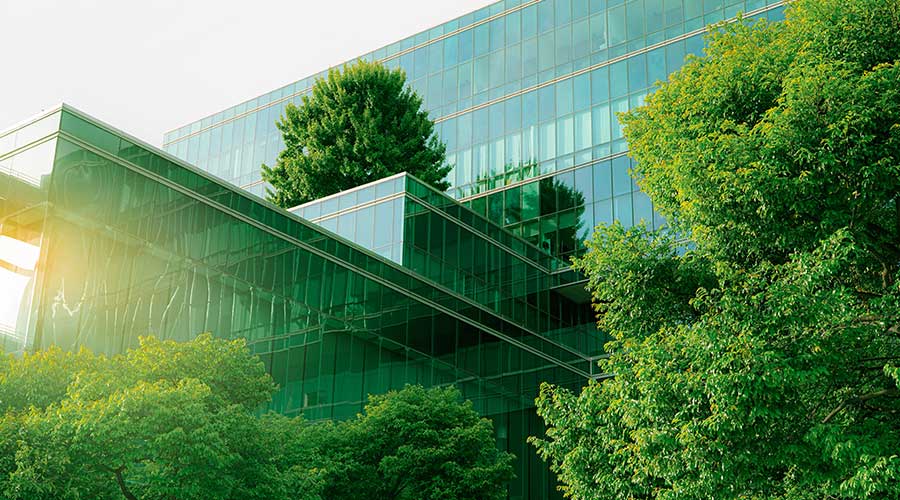The Legalese of Green
Also in this report
The Legalese of Green
News Briefs
Green Business 2008
Merch Mart: LEED Silver
From Somber to Silver
The meteoric rise of the green building industry has given rise to several unintended consequences. One is the question whether or not some of the new strategies used in green buildings open owners and design teams up to greater liability.
So far, there has been little discussion of how owners can address green building in their design and construction contracts to mitigate liability. But it’s an issue all facility executives must consider before taking on a green building project.
Reducing the likelihood of problems is the best way to avoid liability. In green building, this is first accomplished by making the decision to build green at the earliest stages of project planning. Studies consistently show that green building is cost neutral when adopted early.
Likewise, the potential for problems increases when green building is added as an afterthought to an existing design. Most importantly, early adoption enables owners to build a project team that has the requisite green building experience. Solicitations for design and construction professionals should convey the owner’s green building goals, including any desired level of LEED certification, and request detailed explanation and references demonstrating not only the respondents’ green building experience but that of their subconsultants and subcontractors as well.
For public projects and other situations where competitive bidding is required, owners should use a pre-qualification process to provide a field of qualified bidders. Claimed experience should be incorporated into project contracts as representations and warranties.
The experience of any firm is only as good as the people it assigns to manage the project. Owners should require their architects, engineers and contractors to assign project managers or superintendents who have solid green building experience, and they should be identified by name in the relevant contracts. Professional certification as a LEED Accredited Professional is highly desirable.
Problems frequently occur when a contractor or architect changes staffing during a project. That’s because the replacements have no experience with the project or players. This is especially true in green building. Project contracts should prohibit architects and contractors from changing designated project managers or superintendents without the owner’s prior written consent.
As with any construction project, it is essential that responsibilities be clearly assigned among the project team. Contract and construction documents must clearly assign responsibility for each green building element to avoid confusion, especially among subcontractors who often have less green building experience and understanding. This is especially true for projects seeking LEED certification, because the U.S. Green Building Council (USGBC) certifies projects based on submittals that show that each credit was actually implemented.
The LEED scorecard listing each point the project seeks can be a useful tool in this effort. Because documentation is so pivotal, contracts should clearly assign record-keeper responsibilities among the project team in a form that is consistent with LEED requirements.
Contracts should also specify a tracking process to monitor ongoing and timely submission of necessary information. Doing so will help avoid omissions that can be difficult or impossible to recreate after the fact. Such omissions can jeopardize LEED credits and certification level.
Contract Considerations
Some green building materials and equipment with long lead times may require advance ordering to ensure timely delivery and avoid project delays. Contractors should be required to identify any such items in an early submittal and contract payment provisions should be modified to permit contractor invoicing before such items are used on the project.
Care should be given to ensure that “or equal” clauses in the specifications do not jeopardize green building goals. Appropriate findings should be included in public works contracts to avoid applicable laws that might otherwise permit undesired substitutions.
Project contracts should also include waiver language prohibiting designers or contractors from relying on compliance with green building or LEED requirements as a defense to traditional construction and design claims. For example, the contractor or architect should not be able to escape responsibility for a roof failure by blaming the added weight resulting from the owner’s requirement that solar panels be installed on it.
Instead, require designers and contractors to bring such issues to the owner’s attention before the start of construction so that problems can be addressed early and liability placed on construction and design professionals. Owners should also pursue extended warranties or performance guarantees for experimental or innovative building systems.
Owners should enforce green building requirements by specifying that each project participant’s failure to perform their respective green building obligations is a breach of contract and basis of contract liability, along with appropriate force majeure provisions to accommodate causes beyond the party’s reasonable control.
Prime contracts should define substantial completion in a manner that obligates the contractor to complete building commissioning to ensure that building systems are performing optimally before being relieved from potential liability for late completion.
Design contracts should similarly require their services to continue through project completion and, where applicable, LEED certification, so that the design team is similarly invested in achieving prompt certification and responding to any questions that may arise during the LEED evaluation process. Owners might also consider contract provisions entitling them to hold back some money until the project receives the desired LEED certification.
Dangling Incentives
The carrot is oftentimes more effective than the stick. Owners should consider financial incentives to contractors (prime and subs) who provide successful suggestions leading to improved green building performance or additional LEED points. These create a positive environment where the whole team is encouraged financially to advance the owner’s green building goals.
Finger-pointing among construction and design team participants is common when green building requirements are not met. Owners might consider contract provisions that require the parties to participate in binding arbitration to apportion responsibility that is separate and distinct from the broader claims process. Preference should be given to selecting an arbitrator with green building experience, such as LEED Accredited Professionals.
Finally, many government incentives (see “Understanding Green Building Incentives,” below) are issued before the project has been certified, so permitting authorities often include the applicable green building or LEED eligibility criteria in project conditions of approval. Developers and owners should ensure that the local policy or permit documents specify the consequences if the building does not actually achieve the specified green building goal. Otherwise, they risk an unpleasant situation where they have little bargaining power.
Green building is the natural progression of construction. Owners and developers seeking to maximize their investment are wise to build green. But like everything else, new ways of doing necessitate new ways of thinking.
Understanding Green Building Incentives
Local governments increasingly offer incentives for green building by creating density bonuses, speeding permitting, giving grants and offering property tax credits. Eligibility is frequently tied to the project achieving varying levels of LEED certification. There are resources available online for owners who would like to find out about incentives in their areas.
USGBC maintains an updated and comprehensive list on its Web site: www.usgbc.org. Also, the Database of State Incentives for Renewables and Efficiency is a good source. There are several ways that incentives are specified. Density bonuses are common. For example, Pittsburgh offers up to a 20 percent floor area ratio bonus and an additional 20 percent height variance for nonresidential projects earning LEED certification. Other localities like King County, Wash. (surrounding Seattle), and Pasadena, Calif., offer grants from $15,000 to $30,000 for LEED certification. Pasadena goes a step further by matching the building’s electricity savings for each percentage of efficiency beyond code, up to $100,000. Cities like Baltimore and Cincinnati offer up to 100 percent tax abatement for LEED projects in designated areas for 10 to 15 years.
Cities also are increasingly offering expedited permitting for LEED projects. San Francisco, for example, provides priority permitting for commercial new construction and renovations committing to LEED Gold.
|
Donald Simon is a partner at Wendel, Rosen, Black & Dean, LLP in Oakland, Calif., where he advises clients on transactional and litigations matters surrounding construction, green building and real estate. He is president of Build It Green and co-founder of USGBC’s Northern California Chapter.
| briefings |
50 Ways to Leave Your Energy Bill
As part of its goal of reducing building emissions by 50 percent by 2010 on the way to buildings that are totally carbon neutral by 2030, the American Institute of Architects has released its “50 to 50” list highlighting fossil fuel-reduction strategies. AIA’s Sustainability Discussion Group, a task group of the AIA Board of Directors, selected the strategies based on their ability to reduce carbon emissions and mitigate climate change.
The list encompasses both energy efficiency and renewable energy strategies, and provides an overview of each subject as well as practical tips for implementation and additional resources. The more than 200-page document is available as a free .pdf download.
High-Performance Certification
The American Society of Heating, Refrigerating and Air Conditioning Engineers (ASHRAE) has begun a high-performance building certification that will concentrate on making sure designers and engineers have a well-rounded understanding of how HVAC design is integrated into high-performing, sustainable buildings. The first certification exam will be given June 25 at ASHRAE’s 2008 Annual Meeting in Salt Lake City.
The program combines the criteria of ASHRAE Standards 90.1 (energy efficiency), 62.1 (ventilation) and 55 (thermal comfort) with the innovative approaches included in the Advanced Energy Design Guide series in an integrated design approach that strives to achieve practical, cost-effective high-performance building designs. The content of the exam includes sustainability concepts, HVAC and sustainable processes and environmental improvement programs and rating systems; energy analysis; indoor environment; controls and monitoring; benchmarking with performance metrics; water conservation; commissioning in sustainable construction; and operation and maintenance of high-performance buildings.
The high performance design professional certification is renewable every three years, and those certified must earn 45 professional development hours during that time. Click for more information.
Energy Star Rolls On
The number of commercial buildings and manufacturing plants to earn the ENERGY STAR designation is up by more than 25 percent in the past year.
More than 1,400 buildings and plants earned ENERGY STAR status through the end of 2007, bringing the total to nearly 4,100. The total includes about 1,500 office buildings, 1,300 supermarkets, 820 K-12 schools and 250 hotels. Other types of buildings to receive ENERGY STAR recognition include banks, financial centers, hospitals, courthouses, warehouses and dormitories. For the first time, big-box retail buildings also earned the ENERGY STAR label.
In total, EPA says that these facilities have saved nearly $1.5 billion annually in lower energy bills and prevented carbon dioxide emissions equal to the emissions associated with the electricity use of more than 1.5 million American homes for a year, relative to typical buildings.
New Carbon Calculator
A carbon-offset organization called TerraPass has launched a tool to help organizations calculate their carbon emissions. The Carbon Balanced Business Program takes into account five sources of carbon emission: on-site energy use, off-site server energy use, company vehicles, business travel and employee commuting.
The emissions calculations are based on the World Resources Institute Greenhouse Gas Protocol. The tool displays the emissions from each category in a bar chart.
To use the free calculator, click here then click on “Business Calculator.”
| Popular Science magazine recently published a list of the Top 50 green cities based on electricity (renewables and incentives for efficiency); transportation; green living; and recycling and green perspective.
Here is the top 10:
- Portland, Ore.
- San Francisco, Calif.
- Boston, Mass.
- Oakland, Calif.
- Eugene, Ore.
- Cambridge, Mass.
- Berkeley, Calif.
- Seattle, Wash.
- Chicago, Ill.
- Austin, Tex.
|
|
The Business of Green — 2008
“Green business has shifted from a movement to a market. But there is much, much more to do,” says “State of Green Business 2008,” a 64-page report that focuses largely on the extent to which green building practices are being adopted. The report, by Joel Makower of Greenbiz.com, begins by highlighting the top green stories of 2007 — from climate commitments becoming more important to the trend toward zero emissions and zero waste.
The heart of the report is the GreenBiz Index, which is used to gauge the state of green business. The index includes 20 indicators — green power use, carbon intensity, employee commuting, and paper use and recycling, for example — and rates each indicator as “swim” (making progress), “tread” (holding their own) or “sink” (losing ground).
According to the study, eight indicators are swimming, including clean technology investments, which soared to more than $48 billion in 2007. Green office space was also an indicator deemed soaring, due in large part to the 500 percent increase in the amount of LEED-certified space between 2005 and 2007.
The report says that 10 of the 20 indicators are treading and two indicators — carbon intensity and e-waste being recycled — were categorized as sinking. Even though carbon intensity has declined the past few years, the report argues that it hasn’t declined enough and total carbon emissions are not on pace for the 80 percent decrease in total carbon emissions many scientists have said is needed by 2050 to stave off dramatic climate change.
To read in-depth analyses of each indicator, download the report for free. 
| projects |
No Small Feat: Merchandise Mart Earns Silver
The world’s largest commercial office building, Chicago’s 4.2 million-square-foot Merchandise Mart, has earned a Silver certification in the LEED for Existing Buildings rating system. Built in 1930 as a wholesale center for Marshall Fields, the building now has 22,000 annual visitors and hosts 16 annual trade shows, including NeoCon World’s Trade Fair, a major show for the interior design and construction industry.
Vornado Realty Trust purchased the building in 1998 from the Kennedy family, which had owned it for more than 50 years after family patriarch Joseph Kennedy bought it in 1945. The building is managed by Merchandise Mart Properties Inc. (MMPI), which started on the path to LEED certification in 2005. MMPI had already been doing a number of green strategies, including concentrating on energy efficiency and recycling, when the organizers of NeoCon nudged them to consider pursuing formal LEED certification. Christopher Kennedy, grandson of Joseph Kennedy and president of MMPI, also got some pressure from his brother — noted environmental lawyer Robert Kennedy Jr., who has worked with the Natural Resources Defense Council on environmental goals.
Most of the work for the Merchandise Mart’s LEED certification was documenting strategies already in place. In 2006, MMPI joined Clean Air Counts, a Chicago-area voluntary initiative. Members commit themselves to reducing VOCs and energy use and provide alternative transportation for occupants, all key facets of LEED certification.
In early 2007, MMPI instituted several new initiatives, including using recycled paper for all business purposes, installing motion sensors in restrooms and lower wattage fixtures wherever possible, making an I-Go hybrid car available to tenants and employees 24 hours a day, retrofitting exit lights to require less energy, and implementing an exterior and dock lighting schedule. Additionally, MMPI has instituted an extensive education and training initiative to make sure all occupants and staff are aware of and can participate in green goals. Many of the 700 tenants are also seeking LEED for Commercial Interiors certification.
LEED certification became official in late 2007. 
Social Security Administration: From Somber to Silver
Most people perceive government buildings to be drab, lifelessness fortresses inhabited by bespectacled bureaucrats. But TVA Architects had other ideas for the Social Security Administration’s Teleservice Center in Auburn, Wash. The new 120,000-square-foot facility was rehabbed from a World War II-era military warehouse that fit the negative stereotype of government facilities to a “T.” The building earned a LEED Silver certification in February 2008, largely because the General Services Administration adapted and reused much of the existing structure. In fact, GSA awarded the architects on the project an Honor Award for Sustainability/Adaptive Reuse.
More than 75 percent of the original structure was preserved, while the asbestos siding was completely removed and lead paint was removed or encapsulated. Also, more than 80 percent of demolition and construction debris was recycled.
The facility uses underfloor air distribution, with all mechanical and electrical distribution systems concealed below the raised floor. The system also includes adjustable diffuser controls so each occupant can control temperature at each workstation. Seventy-five percent of the space is daylit. And GSA contracted to procure 100 percent green power for the facility.
Water conservation and stormwater management were also key facets of the project. Near the building, the architects converted a swath of asphalt into a sculptured, landscaped bioswale to serve double duty as a security measure by adding stand-off distance, and a stormwater management strategy – the bioswale captures 98 percent of surface stormwater runoff.
The building saves about 30 percent on water compared to traditional buildings by using indigenous plants that don’t need much irrigation, along with efficient restroom fixtures and dual-flush toilets. 
|
Related Topics:












